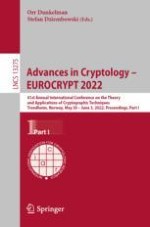The 3-volume-set LNCS 13275, 13276 and 13277 constitutes the refereed proceedings of the 41st Annual International Conference on the Theory and Applications of Cryptographic Techniques, Eurocrypt 2022, which was held in Trondheim, Norway, during 30 May – 3 June, 2022.
The 85 full papers included in these proceedings were accepted from a total of 372 submissions. They were organized in topical sections as follows:
Part I: Best Paper Award; Secure Multiparty Computation; Homomorphic Encryption; Obfuscation;
Part II: Cryptographic Protocols; Cryptographic Primitives; Real-World Systems
Part III: Symmetric-Key Cryptanalysis; Side Channel Attacks and Masking, Post-Quantum Cryptography; Information-Theoretic Security.
